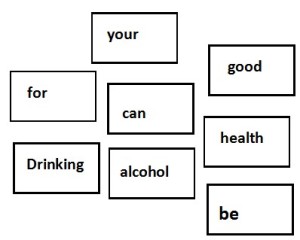- Using an anecdote

You know I play football, right? No? Well I love it. Anyway, I went into town to buy some new boots the other day. I’m in Sports Direct, and I see these Nike boots that I really like, they’re the new model. The assistant comes over and is like
“can I help you?”
And I’m “yeah. Can you tell me how much these are?”
She says “They’re £500”
And I said “£500???? That’s an arm and a leg!”
Here’s some example flashcards I made for teaching idioms. These could also be used for a ‘dingbats’ warmer (see number 22).
- Cuisenaire Rods creation
Give each pair of students a bunch of Cuisenaire rods.
“Work in pairs. Use the rods to create a model of a well-known tourist attraction in [town/city/country/continent]. You have 2 minutes”
Students then look at each model and guess the attraction.
- Cuisenaire Rods model
(Here is my example of the UK political parties and their share of the vote, for a recent lesson on politics)

- Musical “Guess the topic”
Think of 3 or 4 songs which in some way reference the theme/topic of your lesson
Avril Lavigne – Skater Boi (“he was a boy, she was a girl, can I make it any more obvious?”)
The Hollies – He ain’t heavy (he’s my brother)
Baz Luhman – Everybody’s free to wear sunscreen (“maybe you’ll marry, maybe you won’t…”)
Ozzy Ozbourne – Mama I’m coming home
Play students a relevant segment of the song (where something about the topic is referenced). Ask them to write notes on what they hear, compare notes, and guess the topic of the lesson.
- Family fortunes (my favourite)
Create a fake family fortunes style question:
“We asked 100 people from England, Scotland and Wales – which things make you a typical Brit?”
Board the following
1 ________________ 2 ____________ 3_____________ 4____________ 5____________
Students work in groups to prepare answers. Make it a little game (they win points for each correct answer).
Five possible answers for the above: queuing, drinking tea, talking about the weather, eating fish and chips, having bad teeth.
- Picture parts
Make some extreme close-up pictures of animals. Pass them around and get the students to guess what they are and hence the topic of the lesson
- Picture association “Guess the topic”
Gather pictures of things that people MIGHT do only once in a lifetime.
Examples: drive a Ferrari, skydive, run a marathon, win the lottery(?), see a shooting star(?).




Board the pictures or pass them round, students discuss each one and guess the common theme.
- Complete the sentence
Think of a relevant starter sentence and have students complete in their own words
“The most common time to say sorry is….”
Topic: 2nd conditionals
“If I looked like David Beckham, I would…”
- Me/not me

Get students to create a table with two categories
Read a list of different foods/drinks. Students write each word you dictate into their table in the correct category depending on their tastes. They then compare with their partner/group to see if they are similar or different.
- What are they saying?
Example topic: the royal family

You could also do a caption competition
- Me and my partner questions

Make a series of questions or statements related to the topic. Have students answer the questions themselves. Then, they ask their partner the questions and compare answers. They could do this with two different partners to add more speaking. They could even predict their partners answers first, and see if they were right.
- Classic ‘Find someone who…’ mingle
Example topic: fears/phobias

- Slow reveal…
‘A snake’, ‘a line’, etc.
Encourage creativity. Add the next line, encourages guesses, keep doing this until eventually a student guesses the picture/lesson topic
Example topic: Castles in Britain

- Realia
Bring in 5 items that represent your own hobbies, can students guess pastimes?
Mine – Bit of wool (knitting), keyboard (blogging), crossword, binoculars (birdwatching), rubber chicken (making jokes)
- what happens next?
Example topic: using modal verbs to express probability
Pause clip after 7 seconds. Students discuss what might happen. Give some process language (that player might… it might… maybe… the ball/the player/a fan will… etc). Or give them 3 options for what might happen. Play clip to see if prediction was correct (note: last 10 seconds of this video has some swearing).
- Use authentic listening
Example topic: feelings/emotions
Listen to the following clip. Write down any emotions you feel the speakers express.
Or
Listen to the clip. Circle all the emotions that speakers show
Excitement anger patience shock humour etc
Now let them watch the clip and write down any extra emotions they ‘see’
- Make your own audio
Example topic: giving advice
- Matching quiz
Example topic: passives
Match the inventions to the inventor…
The light bulb was invented by… Alexander Graham Bell
The telephone was invented by… Tim Berners-Lee
The internet was invented by… Thomas Edison
Etc…
- Boggle guess the word
Example topic: Solar System – the planets

- Moving true or false
- Moving agree/disagree
Stand near the door if you agree
Stand in the corner over there (point) if you strongly agree
Stand near Pedro’s desk if you disagree
Etc
Read a statement, students move to the relevant corner, then give them 1 or 2 minutes to discuss the statement with whoever is in the corner. If there is only one person in a particular space then you could bounce a few ideas from each corner as a class discussion, or send a student with a different opinion over to debate it.
- Dingbats
Example topic: technology.
Draw a few dingbats on the board. Students guess the words then guess what the theme of the lesson might be.

(smart phone)
- Discussion questions
Q1: Do you agree with the death penalty?
Q2: ‘life means life’. What does this refer to, and do you agree?
Etc.
- Secret realia
- ‘Coffeepotting’
Example topic: television
Coffeepot was invented in the 1920s, but became popular after World War 2. At first, coffeepots were black and white, but then it changed to colour. Coffeepot is a form of entertainment. These days, almost every household has a coffeepot. (etc…)
- Verbal ‘coffeepotting’
Example topic: MacDonalds
Student: is coffeepot a noun?
Teacher: yes…
Student: can coffeepot be a verb too?
Teacher: no
Student: is coffeepot an object?
Teacher: well, you can have a coffeepot, yes.
Student: is it a place?
Teacher: is what a place?
Student: sorry, is coffeepot a place?
Etc…
- Complete the dialogue (similar to ‘what are they saying’!)
Example topic: how and when to apologise

Man: _______________________________
Woman: ____________________________
- Mnemonic race
Example topic: Feelings
F –antastic
E –xcellent
E – lated
L –azy
I – nsecure
N- auseous!
G- utted
S –tupid
- Whiteboard race
- Categorising
Example topic: health and fitness
Smoking, running, drugs, red wine, football, movies, reading, clubbing, vitamins, snakes, vegetables, birdwatching
Possible student created categories:
Things that benefit your health Things that damage your health unrelated words
(playing) football clubbing (too much) snakes
Smoking (relieve stress) drugs
Reading (relaxation) etc
With this activity, you’ll be surprised at some of the categories. Also, it leads to instant discussion:
‘Snakes are not unrelated, they could seriously damage your health’
‘Smoking is good for you?! No way!’
Etc
- What does that mean?
Example topic: lookalikes
Definitions…
Group 1: like a look (?)
Group 2: to look like something or someone
Group 3: look and act like something
Group 4: be person not you famous (?)
- Organise and discuss

If the topic is particularly familiar or the learners are high level, get them to think of the statement and create the organisation task (statement minimum 8 words or something).
- odd one out
Board 4 or 5 common words related to the topic. Have students decide which word is the odd one out and why. Example topic: jobs/ambitions
Fireman Doctor Teacher Nurse
Student: the odd one out is the teacher as the others save lives
For guessing the topic…
Same thing, but include one word that is not related at all, and see if students mention the topic when they share their opinion!
Example topic: Endangered animals
T-rex dodo rhino woolly mammoth
Student: rhino is the odd one out as the others are extinct
(leads into a discussion on things like threats rhinos might face and introducing term ‘endangered’.
- A conundrum
Topic: giving opinions
Recently, a teacher recommended the ‘do or die’ videos by National Geographic. You’ll find plenty of these on youtube. Choose one relevant to your topic.. here’s an example of one.
- Hangman!
See more at :
http://eltplanning.com/2015/06/22/35-ways-to-introduce-your-lesson-topic/
